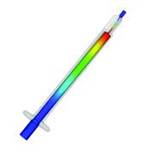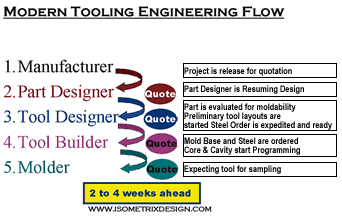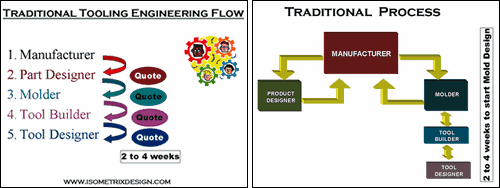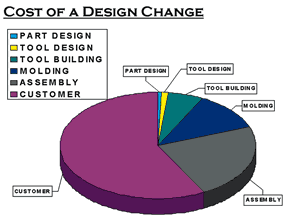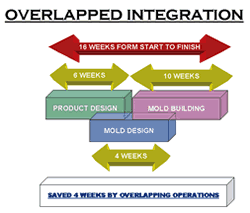The Key to Up-Front Mold Design
By involving the tool designer, builder and molder early in product development, you can reduce turnaround time by weeks or even months, shave weeks off the mold construction cycle and reduce costs by eliminating potential product design troubles.
|
The most time-consuming and costly phase of plastic part production is the mold design and build process. What magnifies this is that when the mold designer gets started is usually when the part to be tooled is discovered not to be moldable. Challenging and expensive mechanisms are needed in order to produce and release the part out of the tool. Some remedies include making use of the tool design phase to finalize the part design; handing off a portion of the part design to a toolmaker; as part of the program, having tooling engineers on staff who understand how molds work and know how to design them; and, operating product and mold design development concurrently. Handy ToolsUntil recently, CAD software's function in the product design process was well identified, but its purpose for mold design was unclear. In the past, most molds were designed by drafting them in 2-D and dimensioning the different details of the mold on blueprints. This information was used exclusively for the tool manufacture, and had very little or no impact upon the part designed. Today, the use of software for mold design is experiencing a remarkable evolution. There are a variety of essential mold design tools available within your current product design software. With the new generation of 3-D solid modeling software, there are highly developed tools that speed up the mold design process, but also examine the part's geometry, simulate analysis and forecast potential tooling problems. Draft analysis, thickness examination, undercut detection, geometry check, parting line recognition, etc., is some of the information you can obtain with the most recent software capabilities. Moreover, with 3-D, advanced tool problems such as sink marks, knit lines and other cosmetic defects can be predicted before any steel gets manufactured. However, the dilemma is that product designers are not acquainted with how to use these capabilities because they are specialized for use by tooling and injection molding engineers. Tooling Background DilemmaMany manufacturing companies have incredibly talented product designers on staff driven by great marketing imagination. They can design wonderfully shaped and sculptured parts with ingenious functions and mechanisms, but also create challenging—and sometimes almost absurd—tooling issues that greatly impact time and cost because these designers lack a tooling background. A mold designer has the skills not only to engineer tooling, but also to examine the piece parts and forecast potential problems with a part design, often with the same 3-D solid modeling software. It is a great policy to invite a mold designer to review meetings and let him learn valuable information about the product while in concept design stages rather than when the product is finalized and expected to be tooled—where no time is projected for revisions or modifications due to stringent delivery times. Traditional Versus ModernTraditional Product-to-Market Approach By the time a product is launched for mold drawing, there is no time available for redesigning a part that could have been fixed earlier if problems were known. Sometimes not even small modifications that could radically improve quality, cost and speed up tool building are permitted because of time constraints. Not only does the tool builder have a promised and strongly enforced delivery date, other mating parts of the same program are dispersed to similar tool shops that are currently working on them. A redesign is not only time consuming, but also very costly—when considering repair work on all the related parts. The traditional product-to-market approach creates long leadtimes. Modern Product-to-Market Approach The mold designer can examine the part prototypes and suggest a few areas of concern to be modified, and discuss any draft issues as well as thick and thin areas. He can start laying out the tool for preliminary sizes and determine a rough parting line, while the part designed is being matured. Once the part gets to its final tweaks, the mold designer can review the tool design and quickly issue steel orders to the builder, so he can start squaring up the different blocks for the tool. After final part is issued, the mold designer can finalize the tool details, while the tool builder can start extracting electrodes and creating CNC toolpaths. This approach can save an enormous amount of time. The Keys to Modern Product DesignTeamwork Cost Overlapped Engineering Tasks AdvantagesThe main advantage of having your tool designer involved earlier is the ability to influence the product and processes being developed. This approach results in added value to your services and creates strong ties with your customer as he becomes more reliant on you to oversee his design process. You can integrate with your customer by catering strong manufacturing skills, value-added services and the ability to anticipate his manufacturing needs. Another great advantage of this concurrency is cross training. As the tool designer learns and understands the use and function of the product developed, the part designer gains the knowledge of tooling concerns and how to correct them. This knowledge gain also is useful for future projects. One last gain is that the mold designer can anticipate potential changes and possible future modifications to the part. When he designs the mold with this in mind, he can keep the tool compatible and avoid expensive repairs in the future. Staying clear from certain areas with components or cooling lines, anticipating future mold inserts, implementing steel safe conditions, or merely protecting certain parts of the mold that might get revised is a tremendous time and cost saving not only at tool build, but also for future modifications. A disadvantage of no communication between designers is a good share of lost time. If the product designer doesn't communicate the part changes quickly enough, the mold designer will waste valuable time designing a tool with an outdated part. Another drawback is in the event of extreme part changes in shape and form with dramatic changes in the parting line. A large amount of mold design work can be trashed if the part undergoes extraordinary modifications. Closer communication and compromise between product designer and mold designer is the answer to time-to-market improvements. A Break for Mold DesignersMold design is a highly demanding profession and a vital function of product development success. The mold engineering practice cannot be expected to be any faster without giving up something. No matter what kind of software or computer you may use, you just can't think faster. This doesn't mean that mold designers should have an unlimited amount of time to perform the job, but at least enough to have an opportunity to study and analyze the part to be molded. The more they know about the part functions and design intent, the more they can spot potential problems down the road. The sooner a mold designer gets involved, the more time that is still on hand to concentrate on potential glitches, and reduce the chances of becoming a victim of designs that are not molder friendly. Up-front mold design allows the engineering team to explore all feasible alternatives early in the process and reduce costly changes later. It prevents the tool builder from wasting a lot of effort having to rework tooling and avoid producing an unacceptable or expensive part. The way to design molds today is not just taking the final product design data sent from the customer, construct parting line surfaces and enclose them with a mold base. You should discuss any improvements or potential issues with the customer. Communicating slight changes in the part design will lead to considerable time and cost savings. If you want to shrink leadtimes, reduce manufacturing costs and create a competitive edge, get a competent mold designer by your side before the product design gets developed. You can have a high rate of return for a relatively small time investment. With an open mind, forward-preventive thinking and a unified vision you too can save time, money and design for manufacture.
|
Related Content
Steps for Determining Better Mold Prices
Improving your mold pricing requires a deeper understanding of your business.
Read MoreThe Role of Social Media in Manufacturing
Charles Daniels CFO of Wepco Plastics shares insights on the role of social media in manufacturing, how to improve the “business” side of a small mold shop and continually developing culture.
Read MoreTop 10 Topics to Cover During an ISO 9001 Manufacturing Audit
Take a look at this practical hands-on approach to conducting a quality audit.
Read MoreDynamic Tool Corporation – Creating the Team to Move Moldmaking Into the Future
For 40+ years, Dynamic Tool Corp. has offered precision tooling, emphasizing education, mentoring and innovation. The company is committed to excellence, integrity, safety and customer service, as well as inspiring growth and quality in manufacturing.
Read MoreRead Next
Why Simulation Matters in Mold Design
If you design molds for a living, chances are there’s simulation software out there that can help you do your job more effectively. But what type of software should you be looking for? The answer is software that enables digital prototyping.
Read MoreReasons to Use Fiber Lasers for Mold Cleaning
Fiber lasers offer a simplicity, speed, control and portability, minimizing mold cleaning risks.
Read MoreHow to Use Strategic Planning Tools, Data to Manage the Human Side of Business
Q&A with Marion Wells, MMT EAB member and founder of Human Asset Management.
Read More
